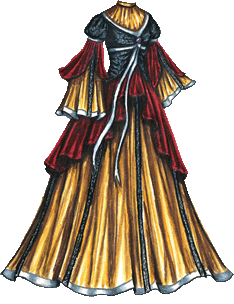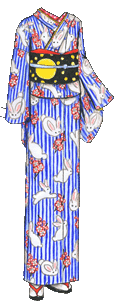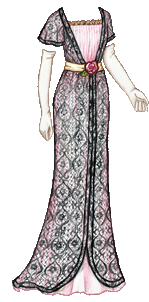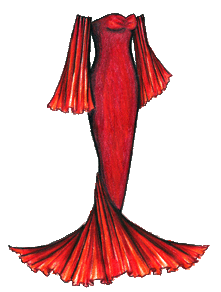 Click for larger version (PNG); click for PDF version. Click here for the list of dolls.
Click for larger version (PNG); click for PDF version. Click here for the list of dolls.
I drew a Halloween costume one year called The Good Queen’s Ghost, a bloody blue and white gown, and ever since I put it up there have been complaints – mostly from my mom – that there’s no clean version. I don’t really like redrawing things, but I thought for this case, I would consider making an exception, and I put up a poll for guidance; the winning option was to redraw it with no blood – but in the colors it was when she was alive, not in the ghostly blue and white. For apparently it is a rule of the paperdollverse that a ghost’s clothes can change after death; the blue and white is not a color combination that she was particularly fond of in life. (I have enough of a morbid streak that I was rather hoping that another bloody dress would win, but now I am quite glad that the winner didn’t call for liberal application of Crimson Red.)
Now, the Good Queen never did have the slightest bit of restraint. I imagine most of you can think of times you have choked back biting, hurtful, self-evidently true words out of prudence, kindness or fear; there was never any such check on her tongue. Perhaps, too, there have been times where you have hidden your most vulnerable or outrageous feelings, times when you’ve wanted to share the very depths of your precious heart with someone and didn’t, or couldn’t. The Good Queen would not have understood such hesitation, and her passionate nature meant that you always knew precisely where you stood with her, whether she loved you, felt entirely indifferent to your very existence or was wondering why you hadn’t done anything useful with your wretched life, like feeding vultures. In turn, where she stood with other people was never of much concern to her: it was not so much that she had no feelings to hurt, for she was a creature of exquisite emotions, but rather that she valued her own feelings too highly to allow them to be affected by any of the ridiculous creatures surrounding her.
You might say it was due to her great power that she felt so free to dispense with the filter that, for most of us, prevents our every thought from being made public, but no: her brother would claim, later, that she was just always like that. You might suspect that it was an act to conceal a deep vulnerability, but I am quite sure that it was not; I think her vulnerabilities lied elsewhere. And in her own way, she was fair: she treasured the advisors and lovers who stood up to her, she never once took her anger out on unfortunate underlings who just happened to be in the way or messengers delivering bad news, and she only told one lie over the whole course of her life. For many people, she inspired confidence as much as she inspired fear or offense, for although she had zero tact, she was never capricious. (In this way, she was rather the opposite of the Twisted Queen, who was by the way a contemporary and not a relative.)
In dress, too, she always did go in for opulence. That she could exist in a world where the rich gold cloth of this dress would turn thin white shows the depth of whatever pain or curse keeps her here; she never would have put up with it in life. Don’t try telling her you think it’s beautiful in its own way – she would have some choice words for you.
Prismacolors used: Cool Grey 20%, 50%, 70%, Black Grape, Imperial Violet, Greyed Lavender, Henna, Black Raspberry, Goldenrod, Bronze, Light Umber, Dark Umber, Jasmine, Cream, Black, Colorless Blender
 Click for larger version (PNG); click for PDF version. Click here for the list of dolls.
Click for larger version (PNG); click for PDF version. Click here for the list of dolls. Share
Share

